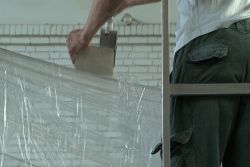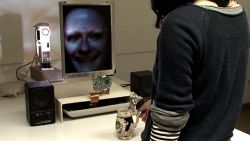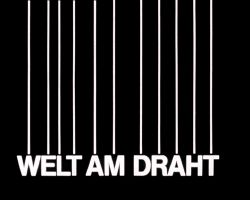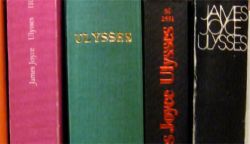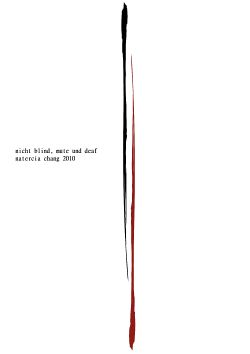Projects from the course Breaking the Timeline, a Fachmodul by Max Neupert, Gestaltung medialer Umgebungen Summer Semester 2010:
Kyd Campbell: TAPE
I have recorded the numen/foruse team building up a large installation of plastic packing tape in the Tempelhof airport in Berlin, for the Design fair. I am now using this footage (very short clips) and the sound from them. I will create tape sounds myself in front of my computer microphone, with a projection behind. and a Pd patch will relate the sounds made to the sounds in small video clips, creating visuals which jump between different clips of my recorded footage of the designers making their tape sculpture. It will be a loud, noisy performance. I used Pure Data to analyze the volume of sounds from a microphone and call up pre-numbered audio and video files.
Hyun Ju Song: Der Emotionsschalter
- Ziel des Projekts: Entwicklung interaktiver Interfaces zur Steuerung von Videos
- Entwicklung im Sommersemester
- Vier Demovideos aufnehmen und editieren
- Programmierung
- Steuerung der Videos (Max)
- Aufbau des Arduinoboards mit Interfaces (Arduino)
- Steuerung der Videos durch die Interfaces (Arduino, Max)
- Produktion von zwei Interfaces (Bierglas, Fischspielzeug)
- Grundbegriff Der Emotionschalter. Man kann durch die Steuerung der Interfaces die Emotion bzw. den Ausdruck der Person auf vier Bildschirmen ändern. Vier Interfaces werden aufgebaut. Jedes Interface hat einen eigenen Emotionsausdruck: kreischen, schluchzen, lachen und schreien.
Matthias Breuer: Reconstructing the truth
In modern times reality is a highly constructed body made up of many different ideas, desires and influences. The biggest reality producing machine, the media with all its different distribution channels, confronts us with a huge moving colourful mass made of countless pictures and sounds. The question about whether what we see is real or not is neither asked nor encouraged. The catchphrase of modernity is see it and believe it, a critical discourse is never held. While in ancient times, following Platon's ideas, reality to some is the dancing of shadows on a cave wall, for us it is the play of many differently coloured pixels on flat surfaces. Screens are our viewfinders to the wold. Our perception is created by artificial interfaces. The connection between reality and man is created by copper wires and silicium plates. A very fragile umbilical cord highly dependent on those who feed it thus holding the ultimate control.
Maureen Anderson: Ulysses: the Remake
Ulysses: the Remake is a project in process utilizing speech-to-text software to experiment with the similarities between the lexicons of both James Joyce’s Ulysses and speech recognition software in order to make a new version of Ulysses. As both are quite broad as well as concerned with and/or confined to their respective contemporaneous use of language, they both play like two parallel infinitesimal points in a vast though limited ocean.
Natercia Chang: nicht blind, mute und deaf
After doing some trial tests on the two ideas I came up for the project, I decided to eleborate the second idea I presented, which is about VO dubbing. The title of the work represents the difference in the visual content and audio content.
It is based on my personal experience in Weimar. I came here without any knowledge of German, it was very hard and frustrating in the beginning; to communicate, to understand and to be understood. I am trying to express an imagery on one's mind (it is my mind that is presented). If things that cannot be comprehended from what one is viewing, the mind would process something intelligible from memory according to one's preference. The project aims to portray the mind as a platform where tempo and spatial can be altered, as well as its ability to separate images and sound, thus creating a new scene of images.
The project is visualized in a three-channel video installation, capturing the random things happened around me in Weimar. The installation is not exhibited in public yet.
Anja Erdmann:
- in this class i will get to work on "Schatten→Klang"
Jeffers Egan:
Theory
Viewing Live AV as a platform for experimentation, my live sets explore the inscription of visual culture in time. By utilizing custom algorithms and animation software and without the use of prerecorded video or still footage, these works result in a hyperreal fluidity of visual mutations, ranging from tightly synchronized passages, to moments of free improvisation. Developing the concepts of digital as organism and software as ecosystem, my sets create a focused, personal aesthetic, finding commonalities in tone, texture and movement between audio and visual elements.
Practice
I have been invited to perform Live Visuals with vidderna, at ROJO/NOVA, a multimedia event this July in São Paulo, Brazil. We will play a 1 hour show together at an event alongside other AV acts.
Technically I am building a visual instrument in Touch Designer, . For the performance with vidderna, I plan to add a HD multi-movie stream compositing system(with alpha), a 3D timeline, and build/consolidate some GLSL shaders into 2D filters I can use in the compositing system.
I will also create new artwork specifically for this performance.
Andreas Beyer: Prosody
the keyword for this projekt is “prosody”, that means the science about rhythm, stress and intonation of speech. I'll try to manipulate any given speech with a specific overlay to generate a new meaning or a strange combination of content and meaning e.g. reading the telephonbook like a holy speech and so on. The "overlayed" "structure" is given by the performer and the imput will be live. I want to realize this with a pd patch that i have to write or build till the semester. The background is a theorie that any kind of speech independent from the cultural background could be identified by anybody because of the intonation, the speech, the pitch (political, religious, news, sport, and so on) - this instrument could be used as a "translater" of the cultural melody of the voice or just to play with different meaning. It is the other way around how an anchorman works, he is trying to speak any typ of news in any combination more or less neutral - this is more difficult than it sounds.
